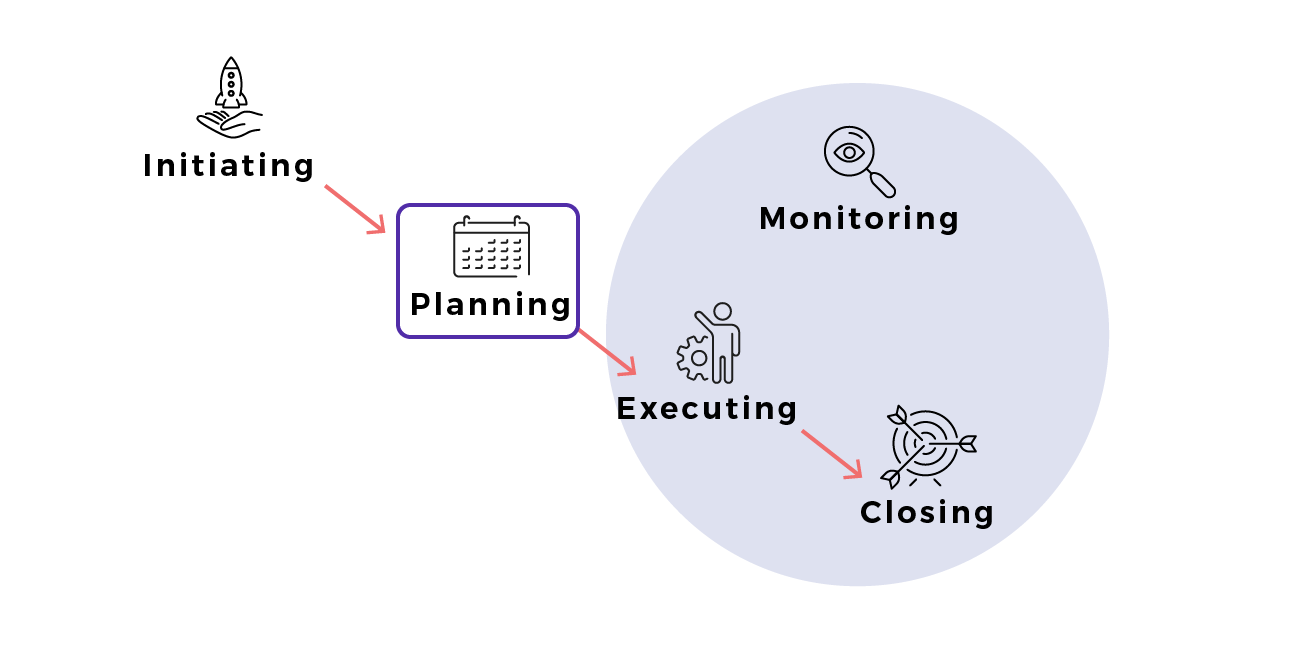In recent chapters, we examined how the initiating phase of the project management lifecycle involved creating business cases, feasibility studies, and project charters. Upon approval of these project documents, the planning phase can begin.

The main activity in the planning phase is to create an in-depth project plan that will generate a time estimate based on requirements and calculate project costs.
Here is a summary of the process:
Break down each requirement into a set of tasks and appoint each to a task owner responsible for executing it.
Work with the project team and the specific task owners to estimate the necessary time to fulfill the tasks and make a realistic plan.
Calculate and validate the cost of completing these tasks.
Add any additional non-resource expenses to arrive at the updated cost of delivering the project.
Step 1. Deconstruct Tasks
With the project team, the first step to successfully planning a project is deconstructing each deliverable into a set of tasks.
Using the example of building a website to launch a new brand for a beverage company, we may divide the task of designing the website's interface as follows:
TASK | TASK OWNER |
Create agency brief | Digital brand manager |
Agency briefing session | Digital brand manager & agency |
Agency build workable template | Agency |
Review the design look & feel | Digital brand manager & agency |
Step 2. Estimate the Time to Fulfill Them
Once the tasks have been deconstructed and assigned, estimate how long it will take to fulfill them.
Continuing with our example of building a website to launch a new brand for a beverage company, in the third column, you can see the estimation in days for each task required to create the website's UI:
TASK | TASK OWNER | ESTIMATE (days) |
Create agency brief | Digital brand manager | 2 |
Agency briefing session | Digital brand manager & agency | 0.5 |
Agency build workable template | Agency | 1.5 |
Review of design look & feel | Digital brand manager & agency | 0.5 |
| Effort to create user interface design | 5.5 |
| Duration to create user interface design | 4.5 |
What is the difference between effort and duration?
Essentially, duration is the amount of time, and effort is the amount of time for all people involved. For example, for the “agency briefing session” task, the digital brand manager and the agency are involved for 0.5 days each, meaning an effort of 1.
How do I assess the duration of a task?
Usually, you work with your project team to validate the duration estimate, but two estimating approaches could help you: analogous and parametric. Let’s use an example to put these in context.
Consider painting a house:
Analogous estimation: House A is about the same size as house B, so it will probably take about the same amount of paint as the previous project.
Parametric estimation: A gallon of paint covers X square feet. Based on house sizes, you can calculate the amount of paint required.
Step 3. Calculate and Validate the Cost of Completing a Set of Tasks
Continuing with the above example, you would then assign the hourly or daily cost of the resources.
Let’s assume the digital brand manager’s daily rate is $350, and the agency’s is $500.
You need the digital brand manager for 3 days, so the cost of this resource will be $350 x 3 = $1,050.
You need the agency for 2.5 days, meaning that will be $500 x 2.5 = $1,250.
So, it will cost $2,300 to complete the tasks.
Step 4. Add any Additional Costs
You would have had an estimate of any additional costs within your business case; however, now that you have a better understanding of the tasks to complete the requirements, it is a good time to validate your direct and indirect costs.
Besides the cost of people’s work to fulfill the project’s tasks, some direct costs to consider could be:
Software licensing costs
Team members travel expenses
Workshop office space rented for a particular project event
Indirect costs would include charges that may be shared across multiple activities or different departments, such as:
Office rent
Employee benefits
Company services like the finance or legal department
Let’s Recap!
You can break down requirements into tasks.
Once you have a set of tasks, you can assign them to team members.
Once you know which team member will do a task, you can work with them to estimate how long each one will take.
With a clearer view of task time estimation, you can calculate and validate resource costs, plus any additional direct or indirect costs.
In this chapter, we looked at how to deconstruct the tasks to estimate the time and cost for each requirement. In the next chapter, we will use these estimates in a project plan. Want to know more? Then let’s continue!
